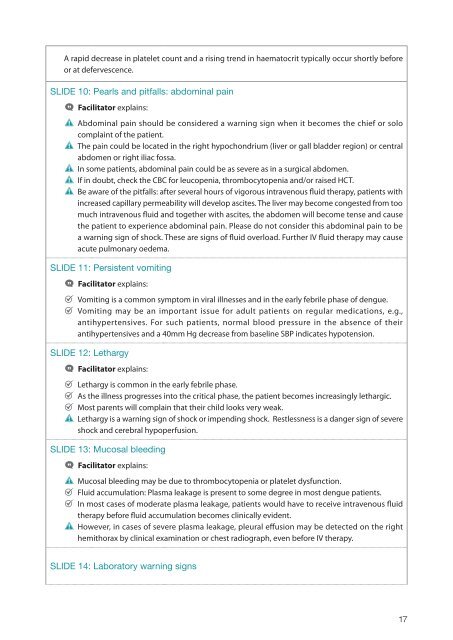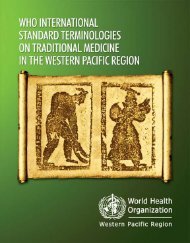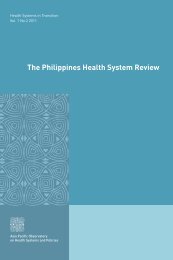Facilitator - WHO Western Pacific Region - World Health Organization
Facilitator - WHO Western Pacific Region - World Health Organization
Facilitator - WHO Western Pacific Region - World Health Organization
Create successful ePaper yourself
Turn your PDF publications into a flip-book with our unique Google optimized e-Paper software.
A rapid decrease in platelet count and a rising trend in haematocrit typically occur shortly before<br />
or at defervescence.<br />
SLIDE<br />
• 10: Pearls and pitfalls: abdominal pain<br />
•<br />
<strong>Facilitator</strong> explains:<br />
•Abdominal pain should be considered a warning sign when it becomes the chief or solo<br />
•<br />
complaint of the patient.<br />
•The pain could be located in the right hypochondrium (liver or gall bladder region) or central<br />
•<br />
abdomen or right iliac fossa.<br />
•<br />
•In some patients, abdominal pain could be as severe as in a surgical abdomen.<br />
•<br />
•If in doubt, check the CBC for leucopenia, thrombocytopenia and/or raised HCT.<br />
•Be aware of the pitfalls: after several hours of vigorous intravenous fluid therapy, patients with<br />
increased capillary permeability will develop ascites. The liver may become congested from too<br />
much intravenous fluid and together with ascites, the abdomen will become tense and cause<br />
the patient to experience abdominal pain. Please do not consider this abdominal pain to be<br />
a warning sign of shock. These are signs of fluid overload. Further IV fluid therapy may cause<br />
acute pulmonary oedema.<br />
SLIDE<br />
• 11: Persistent vomiting<br />
•<br />
<strong>Facilitator</strong> explains:<br />
•<br />
•Vomiting is a common symptom in viral illnesses and in the early febrile phase of dengue.<br />
•Vomiting may be an important issue for adult patients on regular medications, e.g.,<br />
antihypertensives. For such patients, normal blood pressure in the absence of their<br />
antihypertensives and a 40mm Hg decrease from baseline SBP indicates hypotension.<br />
SLIDE<br />
• 12: Lethargy<br />
•<br />
<strong>Facilitator</strong> explains:<br />
•<br />
•Lethargy is common in the early febrile phase.<br />
•<br />
•As the illness progresses into the critical phase, the patient becomes increasingly lethargic.<br />
•<br />
•Most parents will complain that their child looks very weak.<br />
•Lethargy is a warning sign of shock or impending shock. Restlessness is a danger sign of severe<br />
shock and cerebral hypoperfusion.<br />
SLIDE<br />
• 13: Mucosal bleeding<br />
•<br />
<strong>Facilitator</strong> explains:<br />
•Mucosal<br />
•<br />
bleeding may be due to thrombocytopenia or platelet dysfunction.<br />
•Fluid accumulation: Plasma leakage is present to some degree in most dengue patients.<br />
•In most cases of moderate plasma leakage, patients would have to receive intravenous fluid<br />
•<br />
therapy before fluid accumulation becomes clinically evident.<br />
•However, in cases of severe plasma leakage, pleural effusion may be detected on the right<br />
hemithorax by clinical examination or chest radiograph, even before IV therapy.<br />
SLIDE 14: Laboratory warning signs<br />
17

















